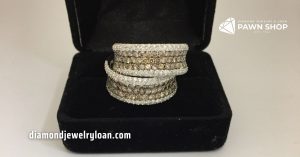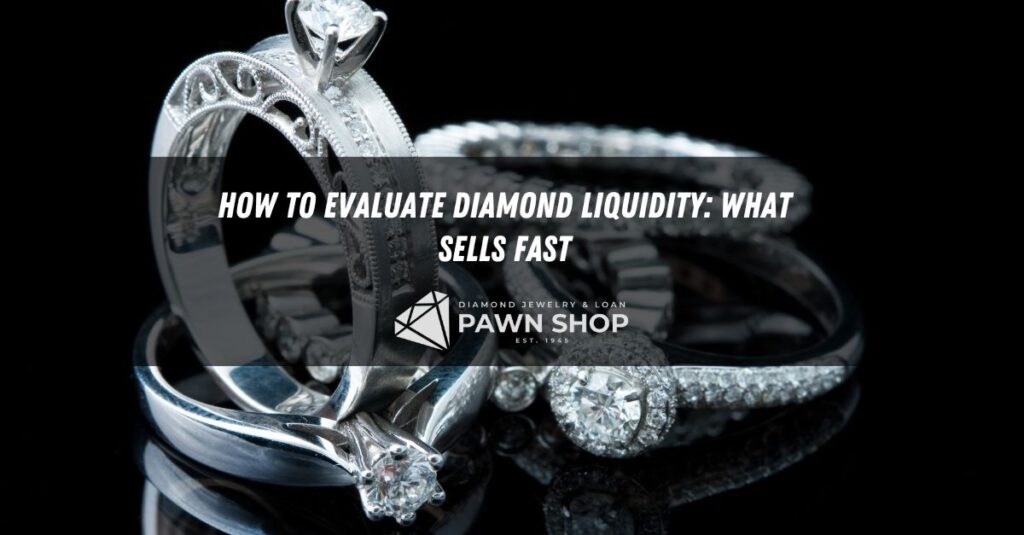Walking into a diamond pawn shop with a piece of jewelry can feel overwhelming. You’re probably wondering whether your diamond ring, necklace, or earrings will actually sell—and for how much. The truth is, not all diamonds are created equal when it comes to resale value and speed of sale.

Understanding diamond liquidity before you visit a pawn shop can help you set realistic expectations and potentially get a better deal. Some diamonds fly off the shelves, while others sit in display cases for months. The difference often comes down to factors that many people don’t consider when buying diamonds retail.
This guide will walk you through the key elements that determine how quickly diamonds sell at pawn shops, what consumers actually want when buying pre-owned diamonds, and how these preferences differ from traditional retail diamond purchases.
The Four Cs That Actually Matter for Resale
When evaluating diamonds for resale, pawn shops focus on the same four fundamental characteristics—cut, carat, clarity, and color—but with a different perspective than retail jewelers.
Cut: Shape Preferences Drive Sales Speed
Round brilliant cut diamonds consistently sell faster than any other shape. These classic cuts appeal to the broadest range of customers and maintain their value better over time. Princess cuts come in second, followed by emerald and cushion cuts.
Fancy shapes like marquise, pear, and heart-shaped diamonds often take longer to sell. While they may be beautiful and unique, the smaller market for these shapes means fewer potential buyers walk through the door looking for them.
Carat Weight: Sweet Spots for Quick Sales
Certain carat weights move much faster than others. Diamonds between 0.50 and 1.25 carats typically sell quickly because they hit the sweet spot of affordability and visual impact for most buyers.
Smaller diamonds under 0.25 carats can be harder to sell individually, though they work well in multi-stone pieces. Very large diamonds over 2 carats, while valuable, have a limited customer base due to their higher price point.
Clarity: Good Enough Often Wins
Here’s where pawn shop sales differ significantly from retail preferences. While retail customers often obsess over internally flawless or very slightly included (VS) grades, pawn shop customers are more practical.
Diamonds with slightly included (SI1 and SI2) clarity grades sell well because they offer good value. The inclusions aren’t visible to the naked eye, but the price point is much more accessible than higher clarity grades.
Color: Near-Colorless Is the Sweet Spot
G, H, and I color grades tend to sell fastest in the secondary market. These near-colorless diamonds look white to most people but cost significantly less than D, E, or F grades. Customers appreciate getting a diamond that looks great without paying premium prices for microscopic differences they can’t see.
Certifications That Move Inventory
Not all diamond certifications carry equal weight in the resale market. Gemological Institute of America (GIA) certifications are gold standard and help diamonds sell faster. American Gem Society (AGS) certifications also perform well.
However, lesser-known certification bodies can actually slow down sales. Many customers either don’t recognize these organizations or don’t trust their grading standards. An uncertified diamond from a reputable source sometimes sells faster than one with a questionable certificate.
When a diamond has proper certification, it provides buyers with confidence and helps justify the price. Pawn shops can move certified diamonds more quickly because customers feel secure in their purchase.
Consumer Trends: Resale vs. Retail Preferences
The secondary diamond market operates differently from traditional retail, and understanding these differences explains why certain diamonds sell faster.
Value-Conscious Shopping Behavior
Pawn shop customers prioritize value over prestige. They want a diamond that looks beautiful and impressive without paying retail markups. This mindset leads to some interesting purchasing patterns.
Customers often choose a larger diamond with slightly lower color or clarity grades over a smaller, technically superior stone. The visual impact matters more than laboratory perfection when you’re getting significantly more diamond for your money.
Setting and Style Preferences
Simple, classic settings sell much faster than elaborate or dated designs. Solitaire engagement rings, simple stud earrings, and tennis bracelets consistently move quickly.
Vintage or antique pieces can be hit or miss. While some customers love the character and craftsmanship of older jewelry, others prefer more contemporary styles. The key is whether the piece feels timeless rather than trendy.
Brand Recognition Impact
Unlike many luxury goods, diamond brand names carry less weight in the pawn shop market. Customers focus more on the diamond’s characteristics and the piece’s overall appeal rather than who manufactured it.
This actually works in favor of both buyers and sellers. Buyers get better value without paying for brand premiums, while sellers can still get fair prices based on the diamond’s inherent quality.
What Slows Down Diamond Sales
Understanding what doesn’t sell quickly can be just as valuable as knowing what does. Several factors can cause diamonds to sit in inventory longer.
Unusual or Trendy Cuts
While fancy cuts might be fashionable at the moment, they often have staying power issues. Heart shapes, marquise cuts, and other unusual shapes appeal to fewer customers, extending the time needed to find the right buyer.
Poor Quality Combinations
Diamonds that combine multiple negative factors—such as poor cut quality with low color grades and visible inclusions—struggle to find buyers even at low prices. Sometimes the sum is worse than the individual parts.
Outdated Settings
Heavy, ornate settings from previous decades can make otherwise beautiful diamonds less appealing. The cost and effort required to reset the stone can deter potential buyers, even when the diamond itself is high quality.
Maximizing Your Diamond’s Appeal
If you’re considering selling diamonds to a pawn shop, several strategies can help your pieces sell faster and potentially for better prices.
Clean and present your jewelry well. A professional cleaning can make a significant difference in how your diamonds appear. Remove any personal engravings if possible, as they can limit appeal to future buyers.
Gather any documentation you have, including original receipts, certificates, or appraisals. While older appraisals don’t determine current value, they provide helpful information about the diamond’s characteristics.
Consider the timing of your sale. Engagement ring sales typically spike before major holidays and during wedding season, while other diamond jewelry may sell more consistently throughout the year.
Finding the Right Diamond Pawn Shop Partner
Not all pawn shops have the same expertise or customer base for diamonds. Look for establishments that specialize in jewelry and have certified gemologists or experienced evaluators on staff.
Research the shop’s reputation and credentials. Established businesses with proper licensing, bonding, and insurance provide more security for both buying and selling transactions. Diamond Jewelry and Loan Pawn Shop in Los Angeles, for example, maintains BBB accreditation and full licensing to ensure customers receive professional service and fair treatment.
A reputable diamond pawn shop will take time to properly evaluate your pieces and explain their assessment. They should be able to discuss the factors that affect your diamond’s marketability and provide realistic expectations about timing and pricing.
Making Informed Decisions About Diamond Liquidity
Understanding what makes diamonds sell quickly at pawn shops helps you make better decisions whether you’re buying or selling. The secondary market rewards practical beauty over technical perfection, and value-conscious customers drive demand for diamonds that look great without premium price tags.
Remember that diamond liquidity depends on finding the right match between your piece and the right customer. A diamond that might sit for months in one location could sell quickly in another market with different customer preferences.
Before making any decisions about selling your diamonds, visit reputable pawn shops to get professional evaluations. Understanding your options and the current market demand will help you make the choice that best fits your needs and timeline.


